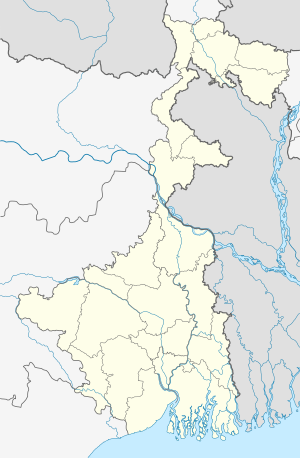Majiara
Majiara is a census town in the Barabani CD block in the Asansol Sadar subdivision of the Paschim Bardhaman district in the Indian state of West Bengal.
Majiara | |
|---|---|
Census Town | |
 Majiara Location in West Bengal, India  Majiara Majiara (India) | |
| Coordinates: 23.724944°N 87.017611°E | |
| Country | |
| State | West Bengal |
| District | Paschim Bardhaman |
| Area | |
| • Total | 7.1883 km2 (2.7754 sq mi) |
| Population (2011) | |
| • Total | 5,444 |
| • Density | 760/km2 (2,000/sq mi) |
| Languages* | |
| • Official | Bengali, Hindi, English |
| Time zone | UTC+5:30 (IST) |
| PIN | 713330 |
| Telephone code | 0341 |
| Vehicle registration | WB |
| Lok Sabha constituency | Asansol |
| Vidhan Sabha constituency | Barabani |
| Website | paschimbardhaman |
Geography
Location
Majiara is located at 23.724944°N 87.017611°E
 |
| Cities, towns and ECL Areas in the western portion of Asansol Sadar subdivision in Paschim Bardhaman district MC: municipal corporation, P: rural administrative centre, CT: census town, N: neighbourhood, OG: out growth, T: temple Owing to space constraints in the small map, the actual locations in a larger map may vary slightly |
The Asansol-Durgapur region is composed of undulating laterite soil. This area lies between two mighty rivers – the Damodar and the Ajay. They flow almost parallel to each other in the region – the average distance between the two rivers is around 30 km. For ages the area was heavily forested and infested with plunderers and marauders. The discovery of coal in the 18th century led to industrialisation of the area and most of the forests have been cleared.[1]
Pangachhiya, Majiara, Bhanowara, Domohani, Charanpur (OG), Ratibati and Chelad form a cluster of census towns and an outgrowth on the northern and eastern sides of Asansol.[2]
Urbanisation
According to the 2011 census, 83.33% of the population of Asansol Sadar subdivision was urban and 16.67% was rural.[3] In 2015, the municipal areas of Kulti, Raniganj and Jamuria were included within the jurisdiction of Asansol Municipal Corporation.[4]Asansol Sadar subdivision has 26 (+1 partly) Census Towns.(partly presented in the map alongside; all places marked on the map are linked in the full-screen map).
Demographics
According to the 2011 Census of India, Majiara had a total population of 5,444 of which 2,813 (52%) were males and 2,631 (48%) were females. Population in the age range 0-6 years was 721. The total number of literate persons in Majiara was 3,341 (70,74% of the population over 6 years).[5]
*For language details see Barabani (community development block)#Language and religion
According to the 2011 census, the urban agglomeration (UA) centred upon Asansol had a population of 1,243,414. In addition to the erstwhile municipalities of Kulti, Jamuria, and Raniganj subsequently incorporated into the Asansol Municipal Corporation, the agglomeration included the census towns of Amkula, Baktarnagar, Ballavpur, Bhanowara, Domohani, Egara, Jemari (J.K. Nagar Township), Majiara, Murgathaul, Raghunathchak, Sahebganj and Topsi, and also Charanpur, an outgrowth of Jamuria.[6][4]
Infrastructure
According to the District Census Handbook 2011, Bardhaman, Majiara covered an area of 7.1883 km2. Among the civic amenities, it had 6 km roads with both open and covered drains, the protected water supply involved overhead tank, tap water from treated sources, handpump, tank, pond, lake. It had 800 domestic electric connections. Among the medical facilities it had 1 dispensary/ health centre, 6 medicine shops. Among the educational facilities it had were 4 primary schools, 1 middle school, the nearest secondary school at Kalla 1 km away, the nearest senior secondary school and the nearest general degree college at Asansol 9 km away. Among the social, recreational and cultural facilities, it had a public library. Among the important commodities it produced was bricks.[7]
Education
Majiarah High School is a Bengali-medium coeducational institution established in 2008. It has facilities for teaching from class V to class VIII.[8]
References
- Chattopadhyay, Akkori, Bardhaman Jelar Itihas O Lok Sanskriti (History and Folk lore of Bardhaman District.), (in Bengali), Vol I, pp 14-15, Radical Impression. ISBN 81-85459-36-3
- "Census of India 2011, West Bengal: District Census Handbook, Barddhaman" (PDF). Map of Barabani CD Block, page 167 and Map of Raniganj CD Block, page 215. Directorate of Census Operations, West Bengal. Retrieved 31 August 2018.
- "District Statistical Handbook 2014 Burdwan". Table 2.2, 2.4(a). Department of Statistics and Programme Implementation, Government of West Bengal. Retrieved 4 September 2018.
- "The Kolkata Gazette" (PDF). Notification No. 335/MA/O/C-4/1M-36/2014 dated 3 June 2015. Department of Municipal Affairs, Government of West Bengal. Archived from the original (PDF) on 12 March 2017. Retrieved 4 September 2018.
- "2011 Census – Primary Census Abstract Data Tables". West Bengal – District-wise. Registrar General and Census Commissioner, India. Retrieved 31 August 2018.
- "Constituents of Urban Agglomerations having population 1 lakh and above" (PDF). Provisional Population Total, Census of India 2011. Government of India. Retrieved 27 August 2018.
- "District Census Handbook Barddhaman, Census of India 2011, Series 20, Part XII A" (PDF). Section II Town Directory, Pages 1179-1210; Statement I: Status and Growth History, Page 1179; Statement II: Physical Aspects and Location of Towns, Page 1188; Statement III: Civic and other Amenities, Page 1191; Statement IV: Medical Facilities, Page 1196; Statement V: Educational, Recreational and Cultural Facilities, Page 1200; Statement VI:Industry and Banking, Page 1209:. Directorate of census Operations V, West Bengal. Retrieved 14 May 2020.CS1 maint: extra punctuation (link)
- "Majiarah High School". Schools.org.in. Retrieved 27 May 2020.